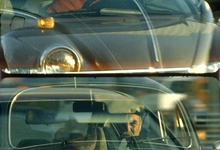Although this film originated, and can now be perceived, primarily as a visual and especially as a kinetic event – at times the whole thing starts to spin like a caroussel –, the social realm is of importance. SUNSET BOULEVARD might be seen as the attempt to simultaneously picture the two big, contradictory myths of U.S. America: the myth of unlimited individualism ("lonesome rider"), and the myth of the ominous "melting pot". All kinds of people are, all in the same way, but mostly alone, caught in their cars, which remind of other containers, between which we are constantly moving back and forth, ultimately in a circular fashion, as suggested on screen. (T.K. 1991)
(Stumbled upon a bit of etymology: the French "boulevard" goes back to the German word "Bollwerk" which means the (circular) fortifications around (old European) cities, which after being razed when they were no longer needed, were transformed into wide splendid streets – boulevards, e.g. the Ringstrasse in Vienna. Now, elevated freeways in and around (U.S.) cities, the film’s locations, are in some way fortifications of our world.) (T.K. 1994)
"SUNSET BOULEVARD: Rush-hour in L.A. at sunset as a highlight of a new short-film generation." (Claus Philipp)
"Makes me want to film cars again." (Ernie Gehr)
This short silent film would appear at first sight to be a purely formal study into form and motion. Filmed from the same angle, the portraits of car drivers appear on screen in rapid succession. The sun is low on the horizon and the lighting of all those lonely drivers is of an unreal beauty. The powerfully repeating shot has in the end a social implication. The boundless individualism of the lonesome rider and the myth of the melting pot are united in the same shot. Stefan Grissemann (Die Presse) described the film as "a series of melancholy detail shots" and called SUNSET BOULEVARD a master piece. (IFF Rotterdam 1993)
Thomas Korschil’s films are clearly tied to a certain tradition of American avant-garde cinema. In SPRING, in SUNSET BOULEVARD and in his latest production, PLATZ DA, HALT, the film-maker, who studied in San Francisco with Ernie Gehr, takes up techniques of structural cinema; Sunset Boulevard uses a simple serial method, by which Korschil, similar to Gehr or the Canadian Michael Snow, produces physically involving cinematic dual aspect images; treacherous examinations of the apparatus of cinema and external reality, with only an initial appearance of monotony. Under the fixed gaze of Korschil’s camera, a busy road becomes a merry-go-round of isolation; a series of faces, each appearing for a fraction of a second from out of the endless stream of traffic; people, alone in their vehicles, which shimmer red and blue in the sun, mere fleeting phantoms in the film material. (Stefan Grisseman 1994)
1 PRINT IN DISTRIBUTION
|
distribution format |
16mm |
|
screen |
1,37 (single screen) |
|
speed |
18 fps |
|
sound |
silent |
|
rental fee |
42,00 € |





